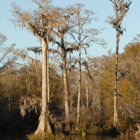
Projects
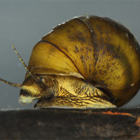
Reports

ARSN Story Video

Alabama’s greatest natural asset is its abundance of freshwater. Over 132,000 miles of streams and rivers flow through the state and it is estimated that 10 percent of the freshwater resources for the entire continental United States originates in or flows through Alabama. For North America, Alabama is home to 27 percent of fish species, 22 percent of crayfish species, 61 percent of freshwater mussel species, 57 percent of freshwater turtle species, and 28 percent of freshwater snail species. Alabama also ranks 4th in the nation for aquatic amphibian and reptile species, and 5th for salamander species. This biodiversity is due in part to the state's many river systems, diverse and ancient geology allowing ample time for speciation, and its subtropical/temperate climate and resulting long growing season. Examining and monitoring this diversity offers Survey biologists the opportunity to assess important factors that affect the quality of our water resources. Moreover, Survey biologists accrue basic aquatic biological information through intensive field work that can be used to monitor and manage Alabama's water resources more effectively and efficiently. This information is used in resource management and species distribution studies and is available for public use.
The Ecosystems Investigations Program (EIP) has three basic research functions: biological surveys, water quality monitoring/assessment, and interdisciplinary watershed studies. Investigations by Survey biologists in the past documented the habitats and distributions of fishes in the Mobile-Tensaw River Delta and the Tennessee, Cahaba, lower Tombigbee, and Black Warrior River systems; in the Gilbertown, Pollard, and Citronelle oil field areas; and in streams draining the Warrior coalfield. For about a decade in the late 1990s the EIP was also actively involved in documenting the movements of large riverine fishes, such as the Southeastern Blue Sucker, Smallmouth Buffalo, Paddlefish, and Gulf Sturgeon. Those studies led to a better understanding of how fishes utilize rivers throughout the year and will assist state and federal conservation agencies and river management agencies to better fulfill their water resources mandates and obligations. Investigating Alabama's rich mussel fauna began in 1992 and continued for about 25 years, updating information on the faunas of each major river basin in the state, including the Alabama, Chattahoochee, Choctawhatchee, Conecuh, Tennessee, and Tombigbee Rivers, and provided the information necessary to guide the creation of Strategic Habitat Units (SHUs) for habitat restoration and species reintroduction efforts currently underway. The Survey maintains small reference collections of fishes, mussels, crayfishes, and aquatic insects that are available for scientific use or public tour. Most of the invertebrate collection was transferred to the Auburn University Museum of Natural History and the fish collection was transferred to the University of Alabama Ichthyological Collection, making that collection one of the largest of its type in the southeast. The crayfish collection is set to be transferred to the University of Alabama Decapod Collection soon. During the early period of mussel research material was donated to The Ohio State University Museum of Biological Diversity and a few smaller museums, but most of the mussel collection was donated to the North Carolina Museum of Natural Science for use in the book Freshwater Mussels of Alabama and the Mobile Basin, published in 2008. More recently Survey biologists assisted in developing distribution information on the relatively unknown crayfish fauna of the state through field collecting and producing species distribution and habitat maps, ultimately leading to the comprehensive book Crayfishes of Alabama.
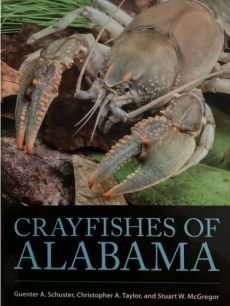
Crayfishes of Alabama, a 496-page book summarizing the state’s crayfish fauna, was published in April 2022. After a cumulative 49 years of research and writing in collaboration with Dr. Guenter A. Schuster, retired Professor Emeritus from Eastern Kentucky University, and Dr. Christopher A. Taylor, Principal Research Scientist and Curator of Fishes and Crustaceans in the Prairie Research Institute of the Illinois Natural History Survey, staff of the Ecosystems Investigations Program co-authored the book, which is the first comprehensive book on the crayfish fauna of the state. It was published by the University of Alabama Press and complements earlier publications defining other major faunal groups in our remarkably diverse waterscape, including fishes (Mettee and others, 1996; Boschung and Mayden, 2004) and mussels (Williams and others, 2008). The book is a significant contribution to the science of crayfishes, as Alabama has more species than any other state, with 100 recognized to date, about 1/4 of the list of crayfishes in North America and 1/6 worldwide. Many of the species are endemic to the state, several others are found only in Alabama and one or a few adjacent states, and many in numerous other states as far north as Canada and west to the Rocky Mountains. Others have been spread by anthropogenic means as far west as California and Hawai’i, and even internationally. The book was based on considerable research into historic records from as far back as 1853, gleaned from countless hours visiting significant museum and university collections and compiling those records into a searchable, georeferenced database. That initial dataset was complemented by thousands of records secured by the authors and a host of willing associates from 2005 up until literally months before publication. Samples were collected broadly across the state, filling in data coverage and habitat gaps based on the historical record, and using means appropriate in the collection area, whether that be by hand-digging, use of baited traps, dipnets and seines, or by hand picking in shallow water. The book includes plates of color photographs of whole animals and key characters, a photographic key, dot distribution maps with physiography and stream bases highlighted, in-depth species accounts, descriptions of morphological characters, crayfish associates, distributions of species across the state and among different habitats, conservation statuses, etc. Research for the book was supported by grants from ADCNR through funds provided by the State Wildlife Grants program and Section 6 of the Endangered Species Act, USFWS, and GSA.
Fishes of Alabama and the Mobile Basin, an 820-page book mapping the distribution of more than 300 species of freshwater and selected marine fishes, was completed in 1996 by Survey biologists in cooperation with the Alabama Department of Conservation and Natural Resources (ADCNR). The book was designed to appeal to a variety of readers from the recreational fisherman to academics and other researchers. Special features of the book include detailed, full-color photographs of more than 300 species of freshwater and marine fishes; color physiographic maps showing dot distributions for 300 fish species in those areas; and a species checklist.
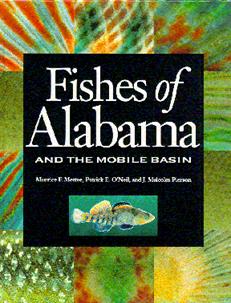
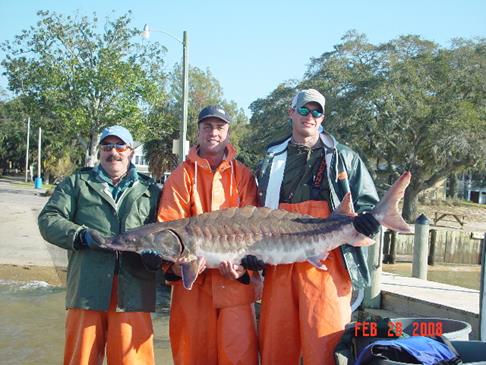
The Ecosystems Investigations Program has also been actively involved in documenting the movements of large riverine fishes in Alabama, such as the southeastern blue sucker, smallmouth buffalo, paddlefish, and Gulf sturgeon. These studies have led to a better understanding of how fishes utilize rivers throughout the year and will assist state and federal conservation agencies and river management agencies to better fulfill their water resources mandates and obligations.
Past biological/water-quality monitoring studies have assessed the impacts of pollution, timber management practices, coalbed methane production, and coal mining on aquatic ecosystems in the Cahaba River and Locust, Mulberry, and Sipsey Forks of the Black Warrior River. Monitoring a population of the endangered Alabama Cave Shrimp and water quality in Bobcat and Matthews Caves, as well as populations of the Tuscumbia Darter in several spring-fed tributaries in the Indian Creek system, all on Redstone Arsenal near Huntsville, provides the U.S. Army with the information it needs to protect these animals and their habitats. Intensive surveys of caves in north Alabama led to the discovery of several new populations of the Alabama Cave Shrimp and provided valuable records of other cave-dwelling species.

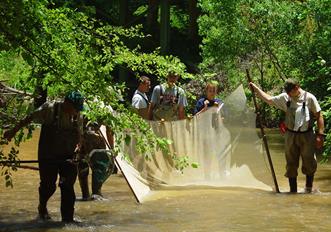
Survey biologists have worked closely with biologists of the Alabama Department of Environmental Management (ADEM) and ADCNR to develop a standardized fish community sampling protocol and statewide analysis tool for evaluating stream biological condition. This tool will be invaluable for evaluating stream water quality and providing biological justification to water quality management decisions. Additionally, the EIP recently partnered with the U.S. Fish and Wildlife Service (USFWS), Cawaco RC&D, and ADCNR to focus on recovery and restoration of rare aquatic animals through a process known as the Strategic Habitat Initiative, which led to the development of the SHU concept. Bringing watershed stakeholders and partners together to improve aquatic habitat and water quality cooperatively will be a significant part of how water resources will be managed and protected in the future, and the Ecosystems Investigation Program is helping to put this process into effect.